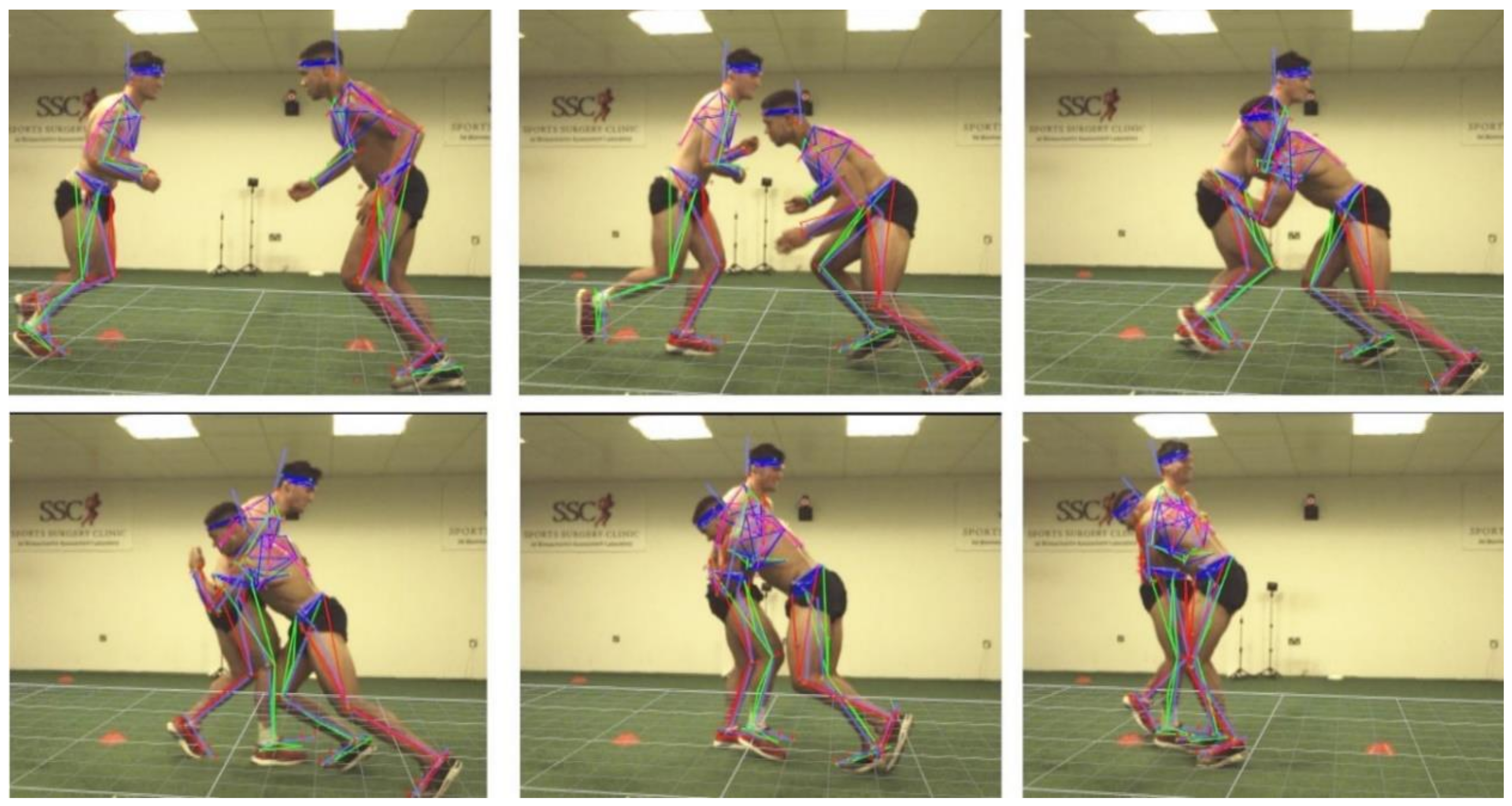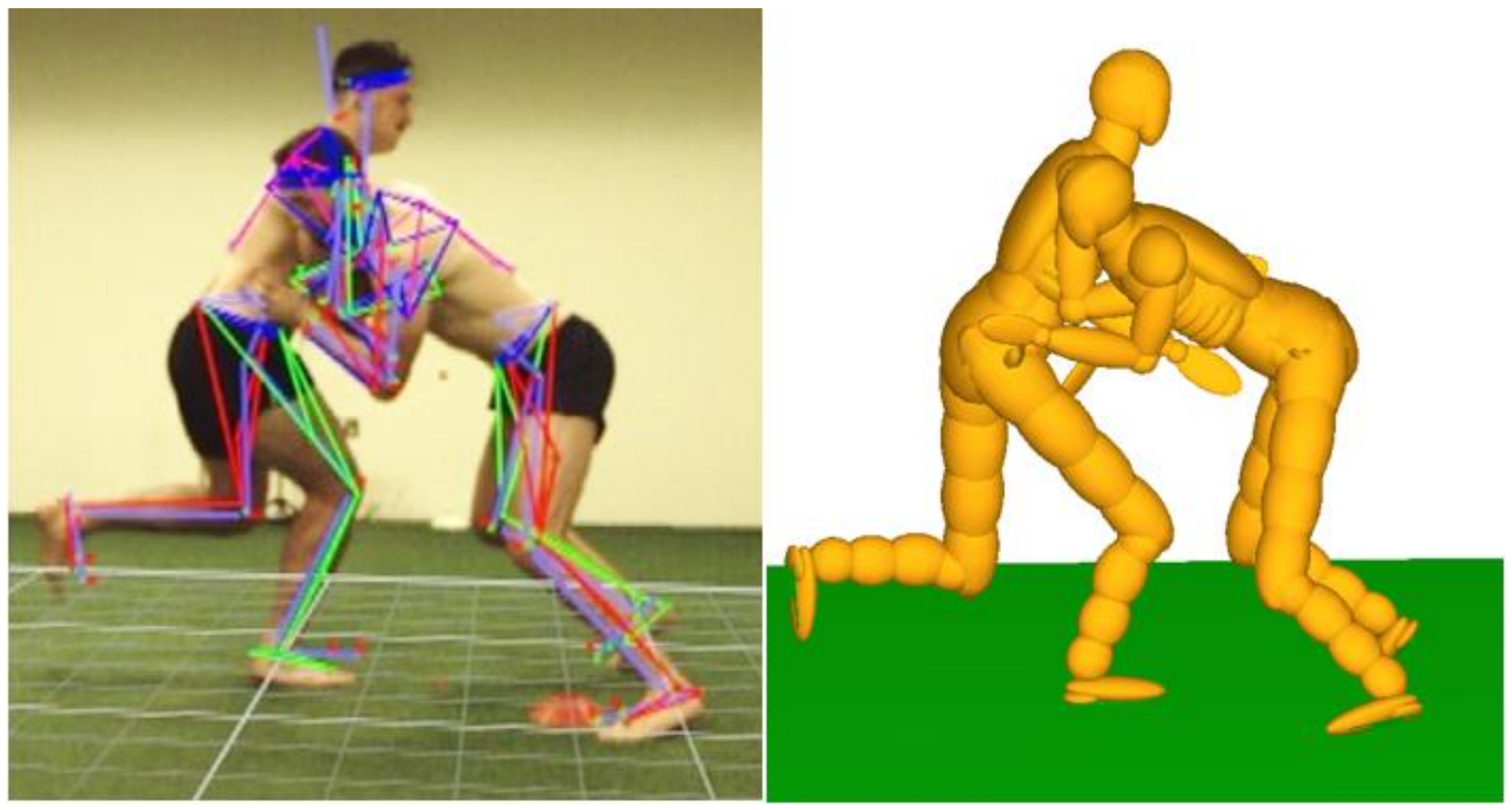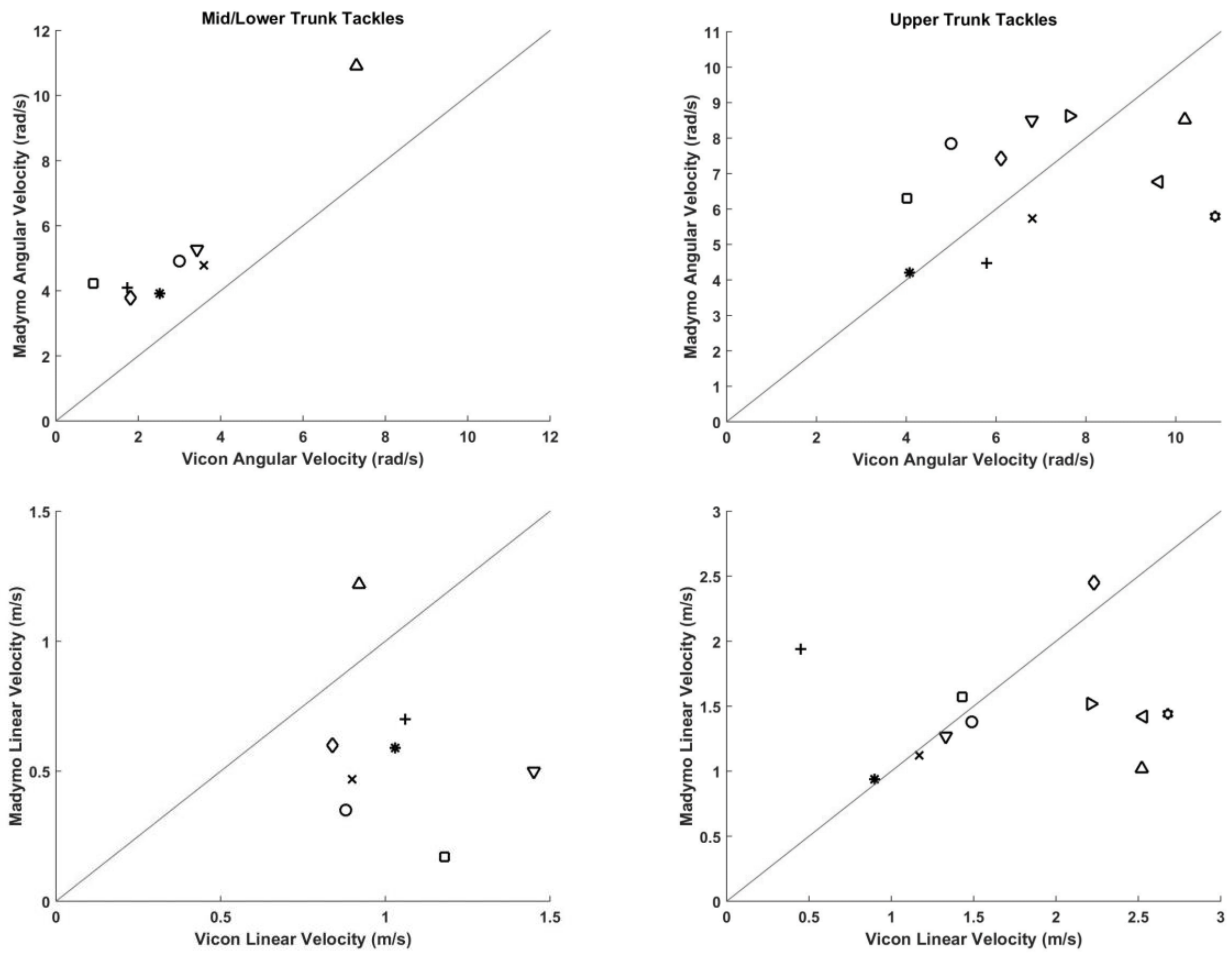Predictive Capacity of the MADYMO Multibody Human Body Model Applied to Head Kinematics during Rugby Union Tackles
Abstract
:1. Introduction
2. Materials and Methods
2.1. Staged Rugby Tackle Laboratory Trials
2.2. Multibody Model Reconstruction
2.3. Statistical Analysis
3. Results
4. Discussion
4.1. General
4.2. Limitations
5. Conclusions
Author Contributions
Funding
Acknowledgments
Conflicts of Interest
References
- Tierney, G.J.; Joodaki, H.; Krosshaug, T.; Forman, J.L.; Crandall, J.R.; Simms, C.K. Assessment of model-based image-matching for future reconstruction of unhelmeted sport head impact kinematics. Sports Biomech. 2017, 17, 33–47. [Google Scholar] [CrossRef] [PubMed]
- Wu, L.C.; Nangia, V.; Bui, K.; Hammoor, B.; Kurt, M.; Hernandez, F.; Kuo, C.; Camarillo, D.B. In vivo evaluation of wearable head impact sensors. Ann. Biomed. Eng. 2016, 44, 1234–1245. [Google Scholar] [CrossRef] [PubMed]
- King, D.; Hume, P.A.; Brughelli, M.; Gissane, C. Instrumented mouthguard acceleration analyses for head impacts in amateur rugby union players over a season of matches. Am. J. Sports Med. 2015, 43, 614–624. [Google Scholar] [CrossRef] [PubMed]
- Fréchède, B.; McIntosh, A. Use of Madymo’s Human Facet Model to Evaluate the Risk of Head Injury in Impact. In Proceedings of the Conference on the Enhanced Safety of Vehicles, Lyon, France, 18–21 June 2007; pp. 18–21. [Google Scholar]
- Frechede, B.; McIntosh, A.S. Numerical reconstruction of real-life concussive football impacts. Med. Sci. Sports Exerc. 2009, 41, 390–398. [Google Scholar] [CrossRef] [PubMed]
- McIntosh, A.S.; Patton, D.A.; Fréchède, B.; Pierré, P.-A.; Ferry, E.; Barthels, T. The biomechanics of concussion in unhelmeted football players in australia: A case–control study. BMJ Open 2014, 4, e005078. [Google Scholar] [CrossRef] [PubMed]
- Tierney, G.J.; Simms, C.K. The effects of tackle height on inertial loading of the head and neck in rugby union: A multibody model analysis. Brain Inj. 2017, 31, 1925–1931. [Google Scholar] [CrossRef] [PubMed]
- Hardy, W.N.; Foster, C.D.; Mason, M.J.; Yang, K.H.; King, A.I.; Tashman, S. Investigation of head injury mechanisms using neutral density technology and high-speed biplanar X-ray. Stapp Car Crash J. 2001, 45, 337–368. [Google Scholar]
- TNO. Madymo Human Body Models Manual Release 7.6; TASS International: Helmond, The Netherlands, 2015; pp. 103–105. [Google Scholar]
- Elliott, J.; Lyons, M.; Kerrigan, J.; Wood, D.; Simms, C. Predictive capabilities of the MADYMO multibody pedestrian model: Three-dimensional head translation and rotation, head impact time and head impact velocity. Proc. Inst. Mech. Eng. Part K J. Multi-Body Dyn. 2012, 226, 266–277. [Google Scholar] [CrossRef]
- Parent, D.P.; Kerrigan, J.R.; Crandall, J.R. Comprehensive computational rollover sensitivity study, part 1: Influence of vehicle pre-crash parameters on crash kinematics and roof crush. Int. J. Crashworthiness 2011, 16, 633–644. [Google Scholar] [CrossRef]
- Tierney, G.J.; Joodaki, H.; Krosshaug, T.; Forman, J.L.; Crandall, J.R.; Simms, C.K. The kinematics of head impacts in contact sport: An initial assessment of the potential of model based image matching. In Proceedings of the ISBS-Conference Proceedings Archive, Tsukuba, Japan, 18–22 July 2016; pp. 108–111. [Google Scholar]
- Tierney, G.J.; Denvir, K.; Farrell, G.; Simms, C.K. The effect of technique on tackle gainline success outcomes in elite level rugby union. Int. J. Sports Sci. Coach 2018, 13, 16–25. [Google Scholar] [CrossRef]
- Tierney, G.J.; Denvir, K.; Farrell, G.; Simms, C.K. Does player time-in-game affect tackle technique in elite level rugby union? J. Sci. Med. Sport 2018, 21, 221–225. [Google Scholar] [CrossRef] [PubMed]
- Deutsch, M.; Kearney, G.; Rehrer, N. Time–motion analysis of professional rugby union players during match-play. J. Sports Sci. 2007, 25, 461–472. [Google Scholar] [CrossRef]
- Quarrie, K.L.; Hopkins, W.G. Tackle injuries in professional rugby union. Am. J. Sports Med. 2008, 36, 1705–1716. [Google Scholar] [CrossRef] [PubMed]
- Tierney, G.J.; Lawler, J.; Denvir, K.; McQuilkin, K.; Simms, C. Risks associated with significant head impact events in elite rugby union. Brain Inj. 2016, 30, 1350–1361. [Google Scholar] [CrossRef] [PubMed]
- Fuller, C.W.; Taylor, A.; Raftery, M. Epidemiology of concussion in men’s elite rugby-7s (sevens world series) and rugby-15s (rugby world cup, junior world championship and rugby trophy, pacific nations cup and english premiership). Br. J. Sports Med. 2015, 49, 478–483. [Google Scholar] [CrossRef]
- Tierney, G.J.; Richter, C.; Denvir, K.; Simms, C.K. Could lowering the tackle height in rugby union reduce ball carrier inertial head kinematics? J. Biomech. 2018, 72, 29–36. [Google Scholar] [CrossRef] [PubMed]
- Tierney, G.J.; Simms, C.K. The effect of intended primary contact location on tackler head impact risk. In Proceedings of the IRCOBI Conference Proceedings, Antwerp, Belgium, 13–15 September 2017; pp. 703–704. [Google Scholar]
- Tierney, G.J.; Simms, C.K. Can tackle height influence head injury assessment risk in elite rugby union? J. Sci. Med. Sport 2018, 21, 1210–1214. [Google Scholar] [CrossRef] [PubMed]
- Richards, J.G. The measurement of human motion: A comparison of commercially available systems. Hum. Mov. Sci. 1999, 18, 589–602. [Google Scholar] [CrossRef]
- Kajzer, J.; Cavallero, C.; Bonnoit, J.; Morjane, A.; Ghanouchi, S. Response of the knee joint in lateral impact: Effect of bending moment. In Proceedings of the IRCOBI Conference Proceedings, Eindhoven, The Netherlands, 8–10 September 1993; pp. 105–116. [Google Scholar]
- Yang, J.; Kajzer, J.; Cavallero, C.; Bonnoit, J. Computer Simulation of Shearing and Bending Response of the Knee Joint to a Lateral Impact; 0148-7191; SAE Technical Paper; SAE International: Warrendale, PA, USA, 1995. [Google Scholar]
- Bouquet, R.; Ramet, M.; Bermond, F.; Cesari, D. Thoracic and pelvis human response to impact. In Proceedings of the Conference on the Enhanced Safety of Vehicles, Munich, Germany, 23–26 May 1994; pp. 100–109. [Google Scholar]
- Viano, D.C. Biomechanical Responses and Injuries in Blunt Lateral Impact; 0148-7191; SAE Technical Paper; SAE International: Warrendale, PA, USA, 1989. [Google Scholar]
- Talantikite, Y.; Bouquet, R.; Ramet, M.; Guillemot, H.; Robin, S.; Voiglio, E. Human thorax behaviour for side impact: Influence of impact mass and velocities. In Proceedings of the Conference on the Enhanced Safety of Vehicles, Windsor, ON, Canada, 31 May–4 June 1998. [Google Scholar]
- Meyer, E.; Bonnoit, J. Le choc latéral sur l’épaule: Mise en place d’un protocole expérimental en sollicitation dynamique. Mémoire de DEA, Université Paris Val de Marne, Faculté de Médecine Pitié-Salpetrière, Ecole National Supérieure des Arts et Métiers de Paris, 1994. [Google Scholar]
- Tierney, G.J.; Lawler, J.; Simms, C.K. Upper and lower body tackles in rugby union: The effect on head kinematics. In Proceedings of the IRCOBI Conference Proceedings, Malaga, Spain, 14–16 September 2016; pp. 381–382. [Google Scholar]
- Hendricks, S.; Karpul, D.; Nicolls, F.; Lambert, M. Velocity and acceleration before contact in the tackle during rugby union matches. J. Sports Sci. 2012, 30, 1215–1224. [Google Scholar] [CrossRef] [PubMed]
- Forman, J.L.; Joodaki, H.; Forghani, A.; Riley, P.; Bollapragada, V.; Lessley, D.; Overby, B.; Heltzel, S.; Yarboro, S.; Weiss, D.B.; et al. Whole-body response for pedestrian impact with a generic sedan buck. Stapp Car Crash J. 2015, 59, 401–444. [Google Scholar]
- Meijer, R.; Van Hassel, E.; Broos, J.; Elrofai, H.; Van Rooij, L.; Van Hooijdonk, P. Development of a multi-body human model that predicts active and passive human behaviour. In Proceedings of the IRCOBI Conference Proceedings, Dublin, Ireland, 12–14 September 2012; pp. 622–636. [Google Scholar]
- Cazzola, D.; Trewartha, G.; Preatoni, E. Analysis of cervical spine loading in rugby scrummaging: A computer simulation approach. In Proceedings of the ISBS-Conference Proceedings Archive, Poitiers, France, 29 June–3 July 2015; pp. 1406–1408. [Google Scholar]
- Tierney, G.J.; Krosshaug, T.; Wilson, F.; Simms, C.K. An assessment of a novel approach for determining the player kinematics in elite rugby union players. In Proceedings of the IRCOBI Conference Proceedings, Lyon, France, 9–11 September 2015; pp. 180–181. [Google Scholar]
- Krosshaug, T.; Bahr, R. A model-based image-matching technique for three-dimensional reconstruction of human motion from uncalibrated video sequences. J. Biomech. 2005, 38, 919–929. [Google Scholar] [CrossRef] [PubMed]
- Tierney, G.J.; Denvir, K.; Farrell, G.; Simms, C.K. The effect of tackler technique on head injury assessment risk in elite rugby union. Med. Sci. Sports Exerc. 2017, 50, 603–608. [Google Scholar] [CrossRef] [PubMed]
- Tierney, G.J.; Denvir, K.; Farrell, G.; Simms, C.K. Does ball carrier technique influence tackler head injury assessment risk in elite rugby union? J. Sports Sci. 2019, 37, 262–267. [Google Scholar] [CrossRef] [PubMed]



| Ball Carrier | Change in Resultant Head Linear Velocity (m/s) | Change in Resultant Head Angular Velocity (rad/s) | |||||||
|---|---|---|---|---|---|---|---|---|---|
| Tackle ID | Closing Speed (m/s) | Vicon | MADYMO | Difference (MADYMO-Vicon) | % Error (% of Vicon) | Vicon | MADYMO | Difference (MADYMO-Vicon) | % Error (% of Vicon) |
| Mid/Lower 2 | 4.04 | 1.03 | 0.59 | −0.44 | −43 | 2.52 | 3.92 | 1.40 | 56 |
| Mid/Lower 3 | 3.06 | 0.88 | 0.35 | −0.53 | −60 | 3.00 | 4.92 | 1.92 | 64 |
| Mid/Lower 4 | 3.70 | 1.06 | 0.70 | −0.35 | −33 | 1.73 | 4.09 | 2.36 | 136 |
| Mid/Lower 5 | 2.89 | 0.90 | 0.47 | −0.43 | −48 | 3.59 | 4.79 | 1.20 | 33 |
| Mid/Lower 6 | 4.20 | 1.45 | 0.50 | −0.95 | −65 | 3.42 | 5.28 | 1.86 | 54 |
| Mid/Lower 7 | 3.78 | 0.84 | 0.60 | −0.24 | −28 | 1.81 | 3.78 | 1.97 | 109 |
| Mid/Lower 8 | 3.85 | 0.92 | 1.22 | 0.30 | 33 | 7.30 | 10.91 | 3.61 | 49 |
| Mid/Lower 9 | 4.22 | 1.18 | 0.17 | −1.01 | −86 | 0.91 | 4.22 | 3.31 | 366 |
| Median (Absolute) | 3.82 | 0.98 | 0.55 | 0.44 | 46 | 2.76 | 4.51 | 1.95 | 60 |
| 25th Percentile (Absolute) | 3.54 | 0.90 | 0.44 | 0.34 | 33 | 1.79 | 4.05 | 1.75 | 53 |
| 75th Percentile (Absolute) | 4.03 | 1.12 | 0.65 | 0.74 | 63 | 3.51 | 5.10 | 2.84 | 123 |
| Upper 1 | 3.87 | 0.90 | 0.94 | 0.04 | 5 | 4.07 | 4.21 | 0.14 | 4 |
| Upper 2 | 3.95 | 1.49 | 1.38 | −0.11 | −7 | 5.00 | 7.85 | 2.85 | 57 |
| Upper 3 | 4.26 | 0.45 | 1.94 | 1.50 | 336 | 5.79 | 4.48 | −1.31 | −23 |
| Upper 4 | 4.05 | 1.17 | 1.12 | −0.05 | −4 | 6.81 | 5.73 | −1.09 | −16 |
| Upper 5 | 4.38 | 1.33 | 1.27 | −0.06 | −4 | 6.80 | 8.51 | 1.71 | 25 |
| Upper 6 | 4.53 | 2.23 | 2.45 | 0.22 | 10 | 6.11 | 7.43 | 1.32 | 22 |
| Upper 7 | 4.88 | 2.52 | 1.02 | −1.50 | −59 | 10.20 | 8.52 | −1.67 | −16 |
| Upper 8 | 4.54 | 1.43 | 1.57 | 0.14 | 10 | 4.02 | 6.30 | 2.28 | 57 |
| Upper 9 | 5.18 | 2.21 | 1.52 | −0.69 | −31 | 7.64 | 8.63 | 0.99 | 13 |
| Upper 10 | 4.57 | 2.53 | 1.42 | −1.11 | −44 | 9.62 | 6.76 | −2.86 | −30 |
| Upper 11 | 4.00 | 2.68 | 1.44 | −1.23 | −46 | 10.87 | 5.79 | −5.08 | −47 |
| Median (Absolute) | 4.38 | 1.49 | 1.42 | 0.22 | 10 | 6.80 | 6.76 | 1.67 | 23 |
| 25th Percentile (Absolute) | 4.03 | 1.25 | 1.20 | 0.09 | 6 | 5.40 | 5.76 | 1.20 | 16 |
| 75th Percentile (Absolute) | 4.56 | 2.38 | 1.55 | 1.17 | 45 | 8.63 | 8.18 | 2.57 | 39 |
© 2019 by the authors. Licensee MDPI, Basel, Switzerland. This article is an open access article distributed under the terms and conditions of the Creative Commons Attribution (CC BY) license (http://creativecommons.org/licenses/by/4.0/).
Share and Cite
Tierney, G.J.; Simms, C. Predictive Capacity of the MADYMO Multibody Human Body Model Applied to Head Kinematics during Rugby Union Tackles. Appl. Sci. 2019, 9, 726. https://doi.org/10.3390/app9040726
Tierney GJ, Simms C. Predictive Capacity of the MADYMO Multibody Human Body Model Applied to Head Kinematics during Rugby Union Tackles. Applied Sciences. 2019; 9(4):726. https://doi.org/10.3390/app9040726
Chicago/Turabian StyleTierney, Gregory J., and Ciaran Simms. 2019. "Predictive Capacity of the MADYMO Multibody Human Body Model Applied to Head Kinematics during Rugby Union Tackles" Applied Sciences 9, no. 4: 726. https://doi.org/10.3390/app9040726
APA StyleTierney, G. J., & Simms, C. (2019). Predictive Capacity of the MADYMO Multibody Human Body Model Applied to Head Kinematics during Rugby Union Tackles. Applied Sciences, 9(4), 726. https://doi.org/10.3390/app9040726





